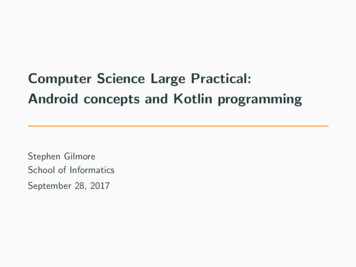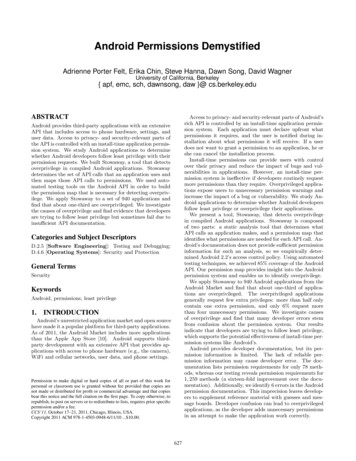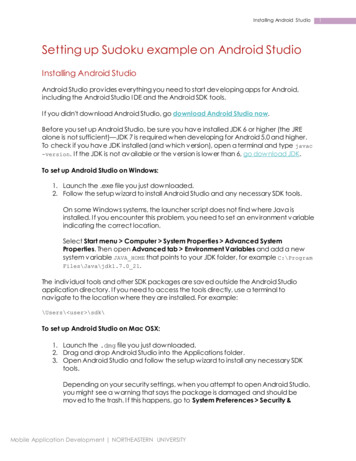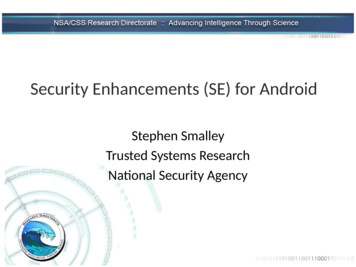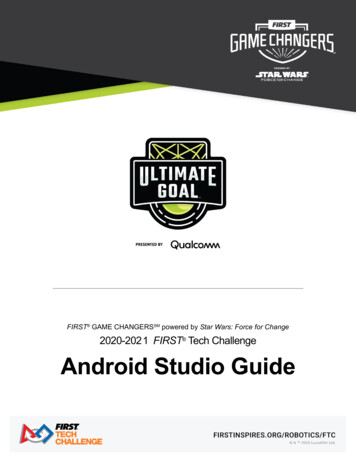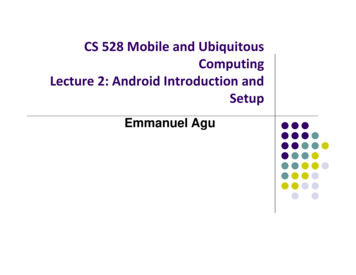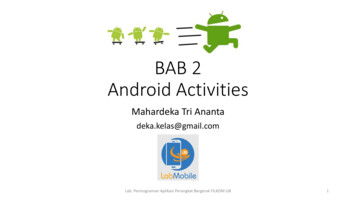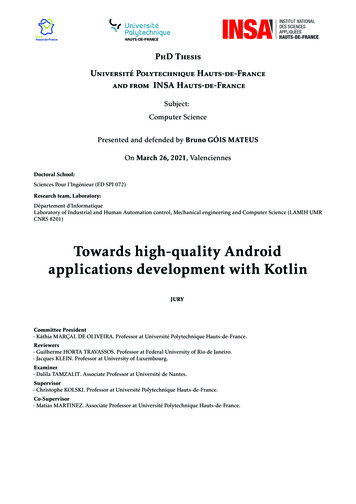
Transcription
PhD ThesisUniversité Polytechnique Hauts-de-Franceand from INSA Hauts-de-FranceSubject:Computer SciencePresented and defended by Bruno GÓIS MATEUSOn March 26, 2021, ValenciennesDoctoral School:Sciences Pour l’Ingénieur (ED SPI 072)Research team, Laboratory:Département d’InformatiqueLaboratory of Industrial and Human Automation control, Mechanical engineering and Computer Science (LAMIH UMRCNRS 8201)Towards high-quality Androidapplications development with KotlinJURYCommittee President- Káthia MARÇAL DE OLIVEIRA. Professor at Université Polytechnique Hauts-de-France.Reviewers- Guilherme HORTA TRAVASSOS. Professor at Federal University of Rio de Janeiro.- Jacques KLEIN. Professor at University of Luxembourg.Examiner- Dalila TAMZALIT. Associate Professor at Université de Nantes.Supervisor- Christophe KOLSKI. Professor at Université Polytechnique Hauts-de-France.Co-Supervisor- Matias MARTINEZ. Associate Professor at Université Polytechnique Hauts-de-France.
ColophonDoctoral dissertation entitled “Towards high-quality Android applications development with Kotlin”, writtenby Bruno GÓIS MATEUS, completed on May 4, 2021, typeset with the document preparation system LATEX andthe yathesis class dedicated to theses prepared in France.
Thèse de doctoratUniversité Polytechnique Hauts-de-Franceet l’ INSA Hauts-de-FranceDiscipline :InformatiquePrésentée et soutenue par Bruno GÓIS MATEUSLe 26 mars 2021, à ValenciennesÉcole doctorale :Sciences Pour l’Ingénieur (ED SPI 072)Equipe de recherche, Laboratoire :Département d’InformatiqueLaboratory of Industrial and Human Automation control, Mechanical engineering and Computer Science (LAMIH UMRCNRS 8201)Vers un développement d’applicationsAndroid de haute qualité avec KotlinJURYPrésidente du jury- Káthia MARÇAL DE OLIVEIRA. Professeure à l’Université Polytechnique Hauts-de-France.Rapporteurs- Guilherme HORTA TRAVASSOS. Professeur au Federal University of Rio de Janeiro.- Jacques KLEIN. Professeur à l’University of Luxembourg.Examinatrice- Dalila TAMZALIT. Maître de conférences hdr à l’Université de Nantes.Directeur de thèse- Christophe KOLSKI. Professeur à l’Université Polytechnique Hauts-de-France.Co-encadrant- Matias MARTINEZ. mcf à l’Université Polytechnique Hauts-de-France.
The Université Polytechnique Hauts-de-France and the INSA Hauts-de-France neither endorse nor censure authors’ opinions expressed in the theses: these opinions must be consideredto be those of their authors.
Keywords: Android development, Kotlin, adoption, evolution, migration, machine learningMots clés : développement Android, Kotlin, adoption, évolution, migration, apprentissageautomatique
This thesis has been prepared atDépartement d’InformatiqueLaboratory of Industrial and Human Automation control, Mechanical engineering andComputer Science (LAMIH UMR CNRS 8201)Université Polytechnique Hauts-de-FranceLe Mont HouyF-59313 Valenciennes Cedex 9
The roots of education are bitter, but thefruit is sweet.Aristotle
xiiiAbstractIn recent years, with more than 3 million applications on its official store, Google’s Android has dominatedthe market of mobile operating systems worldwide. Despite this success, Google has continued evolving itsoperating system and its toolkits to ease application development. In 2017 Google declared Kotlin as anofficial Android programming language. More recently, during the Google I/O 2019, Google announcedthat Android became ‘Kotlin-first’, which means that new API, libraries, and documentation will targetKotlin and eventually Java and Kotlin as preferred language to create new Android applications.Kotlin is a programming language that runs on the Java Virtual Machine (JVM) and it is fully interoperablewith Java because both languages are compiled to JVM bytecode. Due to this characteristic, Androiddevelopers do not need to migrate their existing applications to Kotlin to start using Kotlin in theseapplications. Moreover, Kotlin provides a different approach to write applications because it combinesobject-oriented and functional features. Therefore, we hypothesize that the adoption of Kotlin by developersmay affect different aspects of Android applications’ development. However, one year after this firstannouncement, there were no studies in the literature about Kotlin. In this thesis, we conducted a series ofempirical studies to address these lacks and build a better understanding of creating high-quality Androidapplications using Kotlin.First, we carried a study to measure the degree of adoption of Kotlin. Our results showed that 11% of thestudied Android applications had adopted Kotlin. Then, we analyzed how the adoption of Kotlin impactedthe quality of Android applications in terms of code smells. We found that the introduction of Kotlinin Android applications initially written in Java produces a rise in the quality scores from 50% to 80%according to the code smell considered. We analyzed the evolution of usage of features introduced byKotlin, such as Smart cast, and how the amount of Kotlin code changes over applications’ evolution. Wefound that the number of instances of features tends to grow throughout applications’ evolution. Finally,we focused on the migration of Android applications from Java to Kotlin. We found that 25% of the opensource applications that were initially written in Java have entirely migrated to Kotlin, and for 19%, themigration was done gradually, throughout several versions, thanks to the interoperability between Java andKotlin. This migration activity is challenging because: a) each migrated piece of code must be exhaustivelytested after the migration to ensure it preserves the expected behavior; b) a project can be large, composedof several candidate files to be migrated.In this thesis, we present an approach to support migration, which suggests, given a version of an applicationwritten in Java and eventually, in Kotlin, the most convenient files to migrate. We evaluated our approach’sfeasibility by applying two different machine learning techniques: classification and learning-to-rank. Ourresults showed that both techniques modestly outperform random approaches. Nevertheless, our approachis the first that proposes the use of machine learning to recommend file-level migrations. Therefore, ourresults define a baseline for future work. Since the migration from Java to Kotlin may positively impact theapplication’s maintenance and that migration is time-consuming and challenging, developers may use ourapproach to select the files to be migrated first. Finally, we discuss several research perspectives opened byour results that can improve the experience of creating high-quality Android applications using Kotlin.Keywords: Android development, Kotlin, adoption, evolution, migration, machine learning
xivRésuméCes dernières années, avec plus de 3 millions d’applications sur sa boutique officielle, Android de Google adominé le marché des systèmes d’exploitation mobiles dans le monde entier. Malgré ce succès, Google acontinué à faire évoluer son système d’exploitation et ses kits d’outils pour faciliter le développement desapplications. En 2017, Google a déclaré Kotlin en tant que langage de programmation Android officiel. Plusrécemment, pendant le Google I/O 2019, Google a annoncé qu’Android devenait ‘Kotlin-first’, ce qui signifieque de nouvelles API, bibliothèques et documentations cibleront en priorité Kotlin, et éventuellement Javaet Kotlin, comme langage préféré pour créer de nouvelles applications Android.Kotlin est un langage de programmation qui s’exécute sur la machine virtuelle Java (JVM) et il est entièrement interopérable avec Java car les deux langages sont compilés en bytecode JVM. En raison de cettecaractéristique, les développeurs Android n’ont pas besoin de migrer leurs applications existantes versKotlin pour commencer à utiliser Kotlin dans ces applications. De plus, Kotlin propose une approchedifférente pour écrire des applications car il combine des fonctionnalités orientées objet et fonctionnelles.Par conséquent, nous émettons l’hypothèse que l’adoption de Kotlin par les développeurs Android peutaffecter différents aspects du développement des applications Android. Cependant, un an après cettepremière annonce, il n’y avait aucune étude dans la littérature sur Kotlin. Dans cette thèse, nous avonsmené une série d’études empiriques pour combler ces lacunes et développer une meilleure compréhensionde la création d’applications Android de haute qualité à l’aide de Kotlin.Tout d’abord, nous avons réalisé une étude pour mesurer le degré d’adoption de Kotlin. Nos résultats ontmontré que 11% des applications Android étudiées avaient adopté Kotlin. Ensuite, nous avons analysél’impact de l’adoption de Kotlin sur la qualité des applications Android en termes de défauts de code. Nousavons constaté que l’introduction du code Kotlin dans les applications Android initialement écrites enJava produit une augmentation des scores de qualité de 50% à 80% selon les défauts de code considérés.Nous avons analysé l’évolution de l’utilisation des fonctionnalités introduites par Kotlin, telles que Smartcast, et comment la quantité de code Kotlin change au fil de l’évolution des applications. Nous avonsconstaté que le nombre d’instances de fonctionnalités a tendance à augmenter tout au long de l’évolutiondes applications. Enfin, nous nous sommes concentrés sur la migration des applications Android de Javavers Kotlin. Nous avons constaté que 25% des applications open source initialement écrites en Java ontcomplètement migré vers Kotlin, et pour 19%, la migration s’est faite progressivement, sur plusieursversions, grâce à l’interopérabilité entre Java et Kotlin. Cette activité de migration est difficile car : a)chaque morceau de code migré doit être testé de manière exhaustive après la migration pour s’assurer qu’ilpréserve le comportement attendu ; b) un projet peut être énorme, composé de plusieurs dossiers candidatsà migrer.Dans cette thèse, nous présentons une approche de prise en charge de la migration, qui propose, étant donnéune version d’une application écrite en Java et éventuellement, en Kotlin, les fichiers les plus pratiques àmigrer. Nous avons évalué la faisabilité de notre approche en appliquant deux techniques d’apprentissageautomatique différentes : la classification et l’apprentissage par rang. Nos résultats ont montré que les deuxtechniques surpassent légèrement les approches aléatoires. Toutefois, notre approche est la première àproposer l’utilisation du machine learning pour recommander des migrations au niveau des fichiers. Parconséquent, nos résultats définissent une base de référence pour les travaux futurs. Comme la migration deJava vers Kotlin peut avoir un impact positif sur la maintenance de l’application et que la migration estlongue et difficile, les développeurs peuvent utiliser notre approche pour sélectionner les fichiers à migreren premier. Enfin, nous discutons de plusieurs perspectives de recherche ouvertes par nos résultats quipeuvent améliorer l’expérience de création d’applications Android de haute qualité à l’aide de Kotlin.Mots clés : développement Android, Kotlin, adoption, évolution, migration, apprentissage automatique
AcknowledgmentsI would like to express my gratitude to all the people who have contributed to this thesis’srealization. First, I would like to thank Sylvain Lecomte, for offering me the opportunity to carryout this doctoral work. An exceptional thanks to my co-supervisor, Matias Martinez, thank youfor several hours of daily meetings, for many pieces of advice and discussions that helped meachieve this work. I also want to thank you for your moral support that helped me overcomethe Ph.D. challenges. I truly appreciate all your efforts to make these three years an enjoyableexperience for me. I have learned a lot from you. I also want to thank my advisor, ChristopheKolski, who was essential in the final straight. Thanks for being so kind and for accepting thischallenge. Your experience gave me confidence. Besides my advisor and co-advisor, I would liketo thank the members of my thesis committee: Guilherme Horta Travassos, Jacques Klein, DalilaTamzalit and Káthia Marçal de Oliveira, for their time and feedback. I wish to show my gratitudeto the current and former members of LAMIH team. Thanks for the amusing conversations atlunch, the generous pots, and for the journées du doctorant. I would like to thank the RégionHauts-de-France immensely for the financial support that made this research possible. Last butby no means least, thanks to my family and friends who have provided me moral and emotionalsupport in my life.xv
xviAcknowledgments
ntentsxviiList of TablesxixList of Figuresxxi1 Introduction1.1 Context . . . . . . . . . . . . . . . . . . . . . . . . . . . . . . . . . . . . . . . .1.2 Problems . . . . . . . . . . . . . . . . . . . . . . . . . . . . . . . . . . . . . . .1.2.1 Problem 1 - The lack of knowledge about the adoption of Kotlin . . . . .1.2.2 Problem 2 - The impact in the quality of Android applications . . . . . .1.2.3 Problem 3 - The evolution of Kotlin code . . . . . . . . . . . . . . . . . .1.2.4 Problem 4 - Migrating applications from Java to Kotlin . . . . . . . . . .1.3 Thesis Contribution . . . . . . . . . . . . . . . . . . . . . . . . . . . . . . . . .1.3.1 Contribution 1 - The study about the adoption of Kotlin . . . . . . . . .1.3.2 Contribution 2 - Showing the impact of the adoption of Kotlin on the qualityof Android applications . . . . . . . . . . . . . . . . . . . . . . . . . . . .1.3.3 Contribution 3 - The evolution of Kotlin code in Android applications .1.3.4 Contribution 4 - An approach to assist the migration of Android applications1.4 Outline . . . . . . . . . . . . . . . . . . . . . . . . . . . . . . . . . . . . . . . .2 State of the Art2.1 Kotlin . . . . . . . . . . . . . . . . . . . . . . . . . . . . . . . . . . . . . . . .2.1.1 History of Kotlin . . . . . . . . . . . . . . . . . . . . . . . . . . . . . . .2.1.2 Android development using Kotlin . . . . . . . . . . . . . . . . . . . .2.1.3 Literature about Kotlin . . . . . . . . . . . . . . . . . . . . . . . . . . .2.1.4 Summary . . . . . . . . . . . . . . . . . . . . . . . . . . . . . . . . . . .2.2 Quality of Android applications . . . . . . . . . . . . . . . . . . . . . . . . .2.2.1 Identification of code smells in mobile applications . . . . . . . . . . .2.2.2 Analysis over time of code smells . . . . . . . . . . . . . . . . . . . . .2.2.3 The impact of programming languages on the presence of code smells2.2.4 Evolution patterns on Android Applications . . . . . . . . . . . . . . .xvii.1122333444455777810111212141415
xviiiContents.161617182020202527273 Measuring the adoption of Kotlin by Android developers3.1 Study of the adoption of Kotlin . . . . . . . . . . . . . . . . . .3.1.1 Looking for Kotlin-based Android applications . . . . .3.1.2 Analysis method . . . . . . . . . . . . . . . . . . . . . . .3.1.3 Results . . . . . . . . . . . . . . . . . . . . . . . . . . . .3.2 Study of The proportion of Kotlin code in Android applications3.2.1 Applications analyzed in the study . . . . . . . . . . . .3.2.2 Analysis method . . . . . . . . . . . . . . . . . . . . . . .3.2.3 Results . . . . . . . . . . . . . . . . . . . . . . . . . . . .3.3 Threats to Validity . . . . . . . . . . . . . . . . . . . . . . . . .3.3.1 Internal . . . . . . . . . . . . . . . . . . . . . . . . . . . .3.3.2 External . . . . . . . . . . . . . . . . . . . . . . . . . . .3.4 Summary . . . . . . . . . . . . . . . . . . . . . . . . . . . . . .293030323536373738383939394 Measuring and Comparing the quality of Android applications written in Kotlin4.1 Study design . . . . . . . . . . . . . . . . . . . . . . . . . . . . . . . . . . . . .4.1.1 Tool selection . . . . . . . . . . . . . . . . . . . . . . . . . . . . . . . . .4.1.2 Code smell selection . . . . . . . . . . . . . . . . . . . . . . . . . . . . . .4.2 Comparing the quality of Kotlin-based and Java-based Android applications .4.2.1 Applications analyzed in the study . . . . . . . . . . . . . . . . . . . . .4.2.2 Analysis method . . . . . . . . . . . . . . . . . . . . . . . . . . . . . . . .4.2.3 Results . . . . . . . . . . . . . . . . . . . . . . . . . . . . . . . . . . . . .4.3 Measuring the impact on the quality of introducing Kotlin . . . . . . . . . . .4.3.1 Applications analyzed in the study . . . . . . . . . . . . . . . . . . . . .4.3.2 Defining a quality model . . . . . . . . . . . . . . . . . . . . . . . . . . .4.3.3 Training a quality model . . . . . . . . . . . . . . . . . . . . . . . . . . .4.3.4 Analysis method . . . . . . . . . . . . . . . . . . . . . . . . . . . . . . . .4.3.5 Results . . . . . . . . . . . . . . . . . . . . . . . . . . . . . . . . . . . . .4.4 Threats of validity . . . . . . . . . . . . . . . . . . . . . . . . . . . . . . . . . .4.4.1 Internal . . . . . . . . . . . . . . . . . . . . . . . . . . . . . . . . . . . . .4.4.2 External . . . . . . . . . . . . . . . . . . . . . . . . . . . . . . . . . . . .4.5 Summary . . . . . . . . . . . . . . . . . . . . . . . . . . . . . . . . . . . . . . .4142424345454546505050515153565656575 Analyzing the evolution of Kotlin code in Android applications5.1 Analyzing the code evolution of Android applications . . . .5.1.1 Applications analyzed in the study . . . . . . . . . . .5.1.2 Code evolution trends . . . . . . . . . . . . . . . . . . .5.1.3 Analysis method . . . . . . . . . . . . . . . . . . . . . .59606060622.32.42.52.2.5 Summary . . . . . . . . . . . . . . . . . . . . . . .Software maintenance and evolution . . . . . . . . . . .2.3.1 Programming language evolution . . . . . . . . .2.3.2 Programming language migration . . . . . . . . .2.3.3 Summary . . . . . . . . . . . . . . . . . . . . . . .Machine learning applied to software engineering . . .2.4.1 Classification applied to software engineering . .2.4.2 Learning-to-rank applied to software engineering2.4.3 Summary . . . . . . . . . . . . . . . . . . . . . . .Conclusion . . . . . . . . . . . . . . . . . . . . . . . . .
Contents.636666677074758182836 Applying machine learning to assist the migration of Android applications6.1 Study design . . . . . . . . . . . . . . . . . . . . . . . . . . . . . . . . .6.1.1 Approach . . . . . . . . . . . . . . . . . . . . . . . . . . . . . . . .6.1.2 Projects analyzed in the study . . . . . . . . . . . . . . . . . . . .6.1.3 Feature extraction . . . . . . . . . . . . . . . . . . . . . . . . . . .6.2 Research Question 9 . . . . . . . . . . . . . . . . . . . . . . . . . . . . .6.2.1 Model training . . . . . . . . . . . . . . . . . . . . . . . . . . . . .6.2.2 Evaluation . . . . . . . . . . . . . . . . . . . . . . . . . . . . . . .6.2.3 Results . . . . . . . . . . . . . . . . . . . . . . . . . . . . . . . . .6.3 Research Question 10 . . . . . . . . . . . . . . . . . . . . . . . . . . . .6.3.1 Model training . . . . . . . . . . . . . . . . . . . . . . . . . . . . .6.3.2 Evaluation . . . . . . . . . . . . . . . . . . . . . . . . . . . . . . .6.3.3 Results . . . . . . . . . . . . . . . . . . . . . . . . . . . . . . . . .6.4 Discussion . . . . . . . . . . . . . . . . . . . . . . . . . . . . . . . . . .6.5 Threats to Validity . . . . . . . . . . . . . . . . . . . . . . . . . . . . . .6.5.1 Construct validity . . . . . . . . . . . . . . . . . . . . . . . . . . .6.5.2 Internal validity . . . . . . . . . . . . . . . . . . . . . . . . . . . .6.5.3 External validity . . . . . . . . . . . . . . . . . . . . . . . . . . . .6.6 Summary . . . . . . . . . . . . . . . . . . . . . . . . . . . . . . . . . . .8588889192959596979899991001011021021021021037 Conclusion and perspectives7.1 Summary of contributions . . . . . . . . . . . . . . . . . . . . . .7.2 Short-term perspectives . . . . . . . . . . . . . . . . . . . . . . .7.2.1 Kotlin bad practices and code smells . . . . . . . . . . . .7.2.2 Power consumption on Kotlin-based Android applications7.2.3 Feature engineering for assisted migration . . . . . . . . .7.3 Long-term perspectives . . . . . . . . . . . . . . . . . . . . . . .7.3.1 Test generation for migration . . . . . . . . . . . . . . . . .7.3.2 Automatic software refactoring for migration . . . . . . . .7.3.3 Cross-platform development using Kotlin . . . . . . . . .7.4 Final words . . . . . . . . . . . . . . . . . . . . . . . . . . . . . .1051051061061061061071071071071085.25.35.1.4 Results . . . . . . . . . . . . . . . . .5.1.5 Threats to Validity . . . . . . . . . . .The usage and evolution of Kotlin features5.2.1 Study Design . . . . . . . . . . . . . .5.2.2 The adoption of Kotlin features . . .5.2.3 The introduction of Kotlin features .5.2.4 The usage evolution of Kotlin features5.2.5 Discussion . . . . . . . . . . . . . . .5.2.6 Threats to Validity . . . . . . . . . . .Summary . . . . . . . . . . . . . . . . . . .xix.Bibliography109A PublicationsPublished: . . . . . . . . . . . . . . . . . . . . . . . . . . . . . . . . . . . . . . . . . .To submit: . . . . . . . . . . . . . . . . . . . . . . . . . . . . . . . . . . . . . . . . . .131131131
xxB Kotlin FeaturesB.1 Type inference . . . . . . . . . . . . . . . . . .B.2 Lambda expressions and Anonymous functionsB.3 Inline Function . . . . . . . . . . . . . . . . . .B.4 Null-safety . . . . . . . . . . . . . . . . . . . .B.5 When expression . . . . . . . . . . . . . . . . .B.6 Default argument . . . . . . . . . . . . . . . . .B.7 Named argument . . . . . . . . . . . . . . . . .B.8 Smart cast . . . . . . . . . . . . . . . . . . . . .B.9 Data classes . . . . . . . . . . . . . . . . . . . .B.10 Range expression . . . . . . . . . . . . . . . . .B.11 Extension function . . . . . . . . . . . . . . . .B.12 String template . . . . . . . . . . . . . . . . . .B.13 Delegation . . . . . . . . . . . . . . . . . . . .B.14 Destructuring declaration . . . . . . . . . . . .B.15 Operator overloading . . . . . . . . . . . . . .B.16 Singleton . . . . . . . . . . . . . . . . . . . . .B.17 Companion Object . . . . . . . . . . . . . . . .B.18 Infix function . . . . . . . . . . . . . . . . . . .B.19 Tail-recursive function . . . . . . . . . . . . . .B.20 Sealed class . . . . . . . . . . . . . . . . . . . .B.21 Type alias . . . . . . . . . . . . . . . . . . . . .B.22 Coroutine . . . . . . . . . . . . . . . . . . . . .B.23 Contract . . . . . . . . . . . . . . . . . . . . . .B.24 Inline class . . . . . . . . . . . . . . . . . . . 40140140142142143143143144145145145
List of Tables2.1 Studies about Kotlin in the literature. . . . . . . . . . . . . . . . . . . . . . . . . .123.1 Steps executed to build a recent version of AndroidTimeMachine. . . . . . . . .3.2 Classification of applications according to their programming language. . . . . .32354.1 Paprika supported code-smells. The column ‘Considered’ shows the 10 codesmells studied in our work (X) and the 7 not studied ( ). . . . . . . . . . . . . .4.2 Percentage of Android applications affected by code smell. An app a is affected bya code smell s if a has at least one instance of s. . . . . . . . . . . . . . . . . . . .4.3 Ratio comparison between Kotlin and Java. The column ‘Cliff’s δ’ shows thedifference between the smell median ratio of pure Kotlin and Java applications:negative values mean that a smell affects fewer entities in Kotlin than in Java. .4.4 Changes on quality scores after introducing Kotlin. . . . . . . . . . . . . . . . .5.1 Classification of Android applications according to the evolution trend of Kotlinand Java source code. . . . . . . . . . . . . . . . . . . . . . . . . . . . . . . . . . .5.2 Kotlin features and their release version. . . . . . . . . . . . . . . . . . . . . . .5.3 This table shows for each Kotlin feature X (rows) and for each evolution formulaf (columns) the number of applications where the formula f better describes theevolution of the feature X. The last row, Total, shows how many features werebetter described by a trend (column) . . . . . . . . . . . . . . . . . . . . . . . . .434749536367806.1 List of collected features grouped by category. . . . . . . . . . . . . . . . . . . . . 946.2 Results of the data extraction. For 1% of GitHub projects the tool failed duringthe extraction. . . . . . . . . . . . . . . . . . . . . . . . . . . . . . . . . . . . . . . 946.3 The precision (Pr), recall (Re), and accuracy (Acc) of the different machine learning models and their training and test datasets. indicates that a metric hasimproved when compared with the empirical study using only Androidj2k dataset.Analogously, indicates that a metric has decreased. . . . . . . . . . . . . . . . . 986.4 Mean Average Precision (MAP) at K of a random approach and LambdaMART. . 1017.1 The short and long-term perspectives of our thesis. . . . . . . . . . . . . . . . . .108B.1 Kotlin features and their release version. . . . . . . . . . . . . . . . . . . . . . . .134xxi
xxiiList of Tables
List of Figures2.1 The evolution of the number of questions about Kotlin on the StackOverflow overtime. The bars in the graph are grouped by color according to the current Kotlinversion in that period. . . . . . . . . . . . . . . . . . . . . . . . . . . . . . . . . . .2.2 Timeline of studies published focused on Kotlin. . . . . . . . . . . . . . . . . . .3.13.23.33.43.5810The steps needed to create the dataset target of this study. . . . . . . . . . . . . .Distribution of number of versions (apk) per application. . . . . . . . . . . . . .Our pipeline to classify Android applications (Section 3.1.2.). . . . . . . . . . . .Distributions between Kotlin and Java applications and versions. . . . . . . . . .To answer our RQ2 , we retrieved the corresponding code repository (e.g., a gitrepository) of each FAMAZOA’s application. Then, for each repository, we executed CLOC to identify the proportion of Kotlin code. . . . . . . . . . . . . . . .3.6 Distribution of applications according the percentage of Kotlin code. 59.43% ofKotlin applications have more than 80% of source code written in Kotlin. . . . .333434364.14.24.34.4455254Steps followed to compare Java and pure Kotlin applications in terms of code smells.Steps followed to measure the impact of introducing Kotlin on applications’ quality.Evolution of quality scores based on CC smell along the version history. . . . . .Three cases of classification of quality trend evolution before and after the introduction of Kotlin code. . . . . . . . . . . . . . . . . . . . . . . . . . . . . . . . . .5.1 Steps executed to perform the analysis of the code evolution trends of Androidapplications. . . . . . . . . . . . . . . . . . . . . . . . . . . . . . . . . . . . . . . .5.2 Evolution trends of Kotlin and Java code. Each plot presents the evolution ofKotlin and Java code along the history of one single application where the x-axiscorresponds to the commits and the y-axis corresponds to the amount of code (i.e.,lines). . . . . . . . . . . . . . . . . . . . . . . . . . . . . . . . . . . . . . . . . . . .5.3 Steps executed in out study about the use of Kotlin features. . . . . . . . . . . . .5.4 Percentage of applications that use a feature. Each bar corresponds to a featureand contains on top the number of applications that use that feature. . . . . . .5.5 Kotlin features normalized. . . . . . . . . . . . . . . . . . . . . . . . . . . . . . . .5.6 Distributions of the number of days between the first Kotlin commit and thecommit that introduces the first instance of a feature. . . . . . . . . . . . . . . . .5.7 Example of evolution trends. The x-axis shows the evolution of an application,i.e., commits, and the y-axis shows the number of occurrences of a feature. . . .xxiii37385561646871727577
xxivList of Figures6.1 Evolution of the number of lines of Java and Kotlin along with the Duolingoapplication’s migration process adapted from [45]. Axis Y shows the amount ofcode (LOC) written, and axis X the time from 2014. . . . . . . . . . . . . . . . . . 866.2 Evolution of amount of Java and Kotlin code (LOC) from real open source application that was migrated completely in one single commit. . . . . . . . . . . . . . . 866.3 This figure shows how our approach applies classification and learning-to-rakingto recommend file-level migrations. In this example, a given project has five filesand according to the technique applied our approach suggests a set of files to bemigrated. . . . . . . . . . . . . . . . . . . . . . . . . . . . . . . . . . . . . . . . . . 896.4 In the development phase, we first collect several projects. Then, we filter projectsthat have migration. Later, we extract features from files and classify files betweenmigrated or not migrated. Finally, using these information we train a model usingprojects with migration. . . . . . . . . . . . .
Due to this characteristic, Android developers do not need to migrate their existing applications to Kotlin to start using Kotlin in these applications. Moreover, Kotlin provides a different approach to write applications because it combines object-oriented and functional features. Therefore, we hypoth


